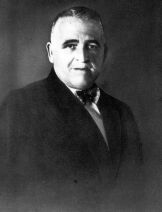
Born: January 22, 1885, Győr,, died: February 28, 1956 Budapest
Frigyes (or Frederic in German) Riesz studied in Budapest. He went to Göttingen and Zurich for further studies and obtained his doctorate from Budapest in 1902. His doctoral dissertation was on geometry. He was appointed to a chair in Kolozsvár in Hungary in 1911. However, the Hungarian government was forced to sign the Treaty of Trianon on 4 June, 1920. Hungary was left with less than one third of the land that had previously belonged to her; Kolozsvár became part of Romania (it was renamed Cluj) and the Hungarian University there had to move to within the new Hungarian borders. Eventually it moved to Szeged in 1920, where there had previously been no university. There, in 1922, Frigyes Riesz and Alfred Haar founded the Bolyai Institute (named after the famous Hungarian mathematician János Bolyai who created hyperbolic geometry, and whose birthplace was Kolozsvár), and started the journal Acta Scientiarum Mathematicarum which quickly became a major source of publications in mathematics. In 1945 Riesz was appointed to the chair of mathematics at the University of Budapest.
Riesz was a co-founder of functional analysis, his work of 1910 marks the start of operator theory. Such fundamental results as the Riesz Representation theorem (the form of functionals on the space of continuous functions), the Riesz-Fischer theorem (completeness of L^2 spaces and identification of different Hilbert spaces) bear his name. Riesz made many contributions to other areas such as ergodic theory, topology, and the theory of orthogonal series. His book Leçon's d'analyse fonctionnelle (written jointly with his student B. Szőkefalvi-Nagy) is one of the best books ever written on functional analysis. Riesz received many honours for his work. He was elected to the Hungarian Academy of Sciences and, in 1949, he received the Kossuth Prize. He was elected to the Paris Academy of Sciences and to the Royal Physiographic Society of Lund in Sweden. He received honorary doctorates from the universities in Szeged, Budapest and Paris.
Frigyes Riesz's younger brother, Marcel Riesz, was himself a famous mathematician. They had only one common work, which contains the famous F. and M. Riesz theorem (a measure on the circle which zero Fourier coefficients with negative index is absolutely continuous with respect to arc measure).
Biography:
http://www-groups.dcs.st-and.ac.uk/~history/Mathematicians/Riesz.html
Book:
Functional Analysis by Frigyes Riesz, Bela Sz.-Nagy, Dover Publications; Reprint edition (June 1, 1990);
Links:
Riesz representation theorem
Riesz-Thorin theorem
Autorithy:
htpp://www.math.u-szeged.hu/confer/fejerriesz/Riesz.htm